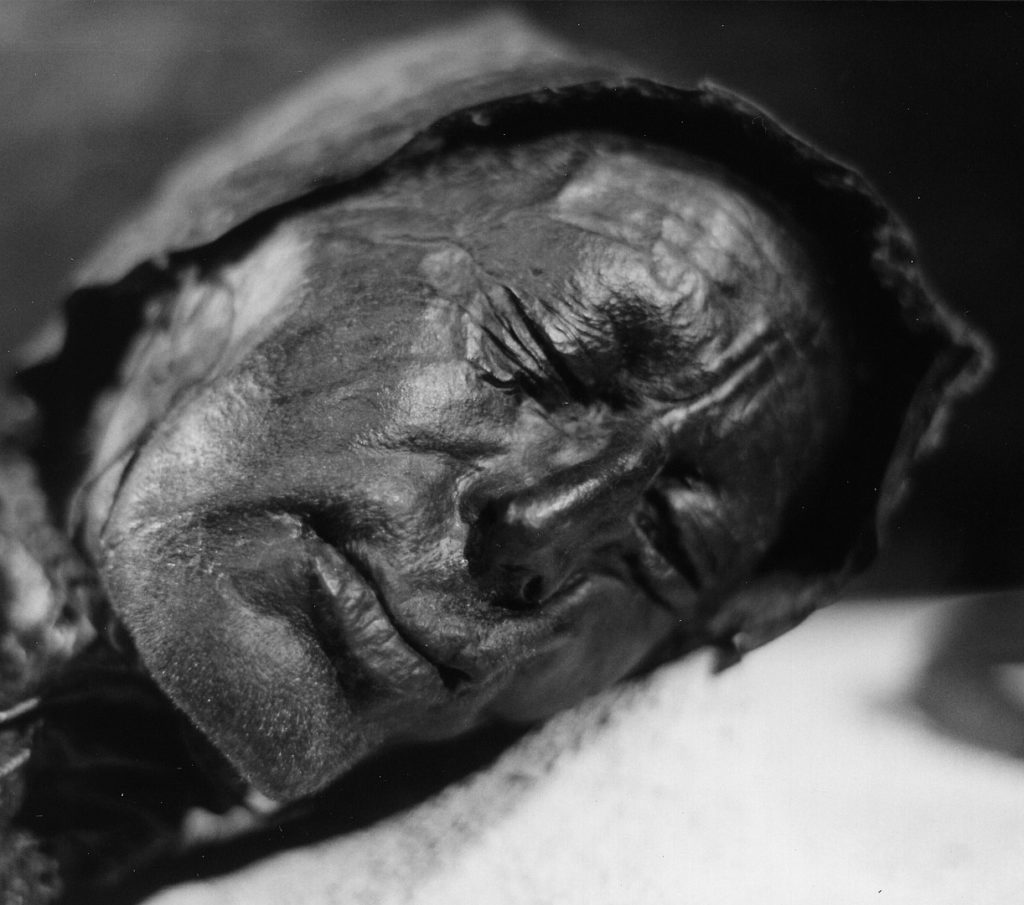
“Head of Bog Body Tollund Man” by Sven Rosborn is licensed under public domain.
I’m holding a silver and turquoise necklace of Bastet, the Egyptian cat-headed goddess in my hands. It belonged to my mother, and even though she is now passed, the necklace remains a connection to her. Objects, especially personal ones, have a quality beyond their simple materiality. In World War II, Nazis collected the eyeglasses, shoes, and other personal effects of Jews killed in gas chambers. Witnessing these piles of personal effects is deeply moving and disturbing, as they seem to still house the essence of living, breathing people. The notion that objects have spiritual qualities is not uncommon. Some cultures, for instance, ritually “kill” personal items of the deceased to release the spirit within. Artifacts hold a similar allure, providing a connection to real people who lived hundreds or even thousands of years before. The idea that old objects contain special qualities is not just a modern one. The Inka of the Andes collected the much earlier Moche pottery and Romans displayed ancient Egyptian artifacts in their homes. “Pot drops”–piles of pottery found on sites in the American Southwest–are thought to be offerings to much earlier sites as a means of connecting with and honoring the ancestors. In short, artifacts are not just objects, they are meaningful to the observers and are potential conduits to the past.
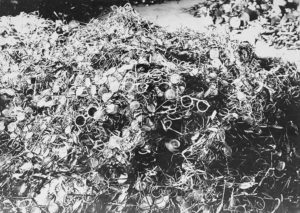
Eyeglass of victims, 1945 by Bundesarchiv Bild is licensed under CC-BY-SA 3.0
Before Archaeology
Given the power and beauty of ancient objects, it is not too surprising that the initial European interest in ancient objects was for their aesthetic quality and not so much for their ability to provide information about the past. Before there was archaeology, there was something called “antiquarianism.” In the Age of Antiquarianism (roughly 1600-the 1800s), aristocrats in Europe were interested in spectacular ancient art objects, with little concern for their method of procurement, what they were used for, or in many instances the context they came from. Museums often competitively sought beautiful objects to foster national pride and sometimes, ethnic supremacy. Excavations were conducted on a grand scale, and in worse-case scenarios, anything not museum-worthy was ignored or discarded. Beautiful ancient works of art were routinely removed from their countries of origin to be displayed in the galleries of Europe. Italian engineer Giovanna Belzoni (1778–1820) pilfered the colossal head of the famous “Young Memnon” (Ramesses II) from Egypt and it still today resides in the British Museum. The “Elgin Marbles,” sculptures from the Parthenon in Athens, Greece, were infamously taken by nobleman Thomas Bruce, a.k.a. Lord Elgin, to the British Museum, where they remain the subject of a debate over ownership. Artifacts were also political currency. Egyptian collections were regularly gifted by the Egyptian government to European countries to establish diplomatic relations.
In contrast to his contemporaries who acquired artwork on dubious terms, Egyptologist Sir William Flinders Petrie (1853–1942) was more interested in understanding the past. He was a pioneer in recognizing that even mundane artifacts and sites are worthy of consideration and can provide information about the past. He was also a big believer in recording the location of artifacts, a practice which today is routine. Petrie’s work initiated the shift away from antiquarianism and toward modern archaeology, where mundane objects were recognized to have value in terms of the insight they could bring to the human past. Petrie’s other claim to fame is that he sometimes appears as a character in Barbara Mertz’s Amelia Peabody series of mystery novels set in Victorian-era Egypt.
Elves and Fairies
For the field of modern archaeology to arise, at least two basic realities had to be recognized. The first seems obvious now; Artifacts had to be recognized as objects made by people. In Europe, it was not uncommon for people to ascribe artifacts to the work of mythical beings like Thor or even elves. In Scotland, arrowheads were called “elf-arrows,” and could be worn to protect against “elf-shot” (Jones and Fellow 1731:58). Gradually, people began pointing out that these mystical curiosities of Europe were not much different from the everyday tools used by people encountered during the colonization of Africa, Australia, and the Americas by European powers. In 1699, Edward Lhuyd, Keeper of Ashmolean Museum in Oxford concluded that mysterious objects found in Scotland were not the work of elves, but were just plain old arrowheads (James and Fellow 1731:124):
I doubt not but you have often seen of those Arrow-heads they ascribe to elves or fairies, they are just the same as the chip’d flints the natives of New England head their arrows with at this day: and there are also several stone hachets (sic) found in this kingdom, not unlike those of the Americans.
The second realization that paved the way for modern archaeology is the recognition of the long period that humans have occupied the Earth. Many scholars attempted to calculate the age of the Earth and/or people on the Earth using the available texts. Archbishop James Ussher’s calculation used, in part, the genealogies and reigns outlined in the Bible along with known dates of rulers. Ussher calculated the beginning of creation (as in Genesis) to 6004 BP (Sunday, October 23 in the Julian calendar; BP means “before present”). Calculating the age of creation was a serious matter of the day, as virtually everyone in Europe was a creationist at the time. Even Sir Isaac Newton attempted an estimate.
While Ussher’s estimate was extremely influential, the physical evidence was not aligning well with this relatively short time frame of human existence of just 6,000 years. In the 1790s, John Frere, great-great-grandfather of famous paleoanthropologist Mary Leakey, excavated stone tools four meters (that’s about 12 feet) below the ground surface in ancient lake deposits in Suffolk, England. How did these artifacts get to be so deep in the ground? Going against conventional thought, Frere concluded somewhat tentatively, “The situation in which these weapons were found may tempt us to refer them to a very ancient period indeed.” A similar situation was coming to light in France. In the 1840s, a customs official named Jacques Boucher de Perthes uncovered stone tools associated with extinct elephant remains (mammoth) deep in ancient Somme River gravels in France. Like Frere, he concluded that the human presence in Europe had to be older than what the Biblical and historical accounts implied. Boucher de Perthes’ other claim to fame is that he shows up in Jules Verne’s 1871 Journey to the Center of the Earth. Today, thanks to these early observers and thousands of subsequent archaeological and geological investigations, the deep age of the earth and human existence presence are overwhelmingly clear. Humans have been in Europe for at least 40,000 years and other related species like Neanderthals were there for hundreds of thousands of years. Chapter 3 goes into more detail about the earliest human sites.
The Three Principles
Both Frere and Perthes were using a concept basic to geology, paleontology, and archaeology, called the Principle of Superposition. The Principle of Superposition is the straightforward observation that lower rock or soil deposits are older than the deposits found higher up. More formally, the Principle of Superposition states that in a sequence of undisturbed strata (layers of cultural and natural deposits) the overlying layer is younger than the one below it. At the Murray Springs Site in Arizona, the strata, or layers, can be seen in a stream channel. Just below the thin black “mat-like” deposit, mammoth bones and evidence of early people were found. Above the black line, the mammoth and most other large-bodied ice-age animals are gone and the tool tradition changes.
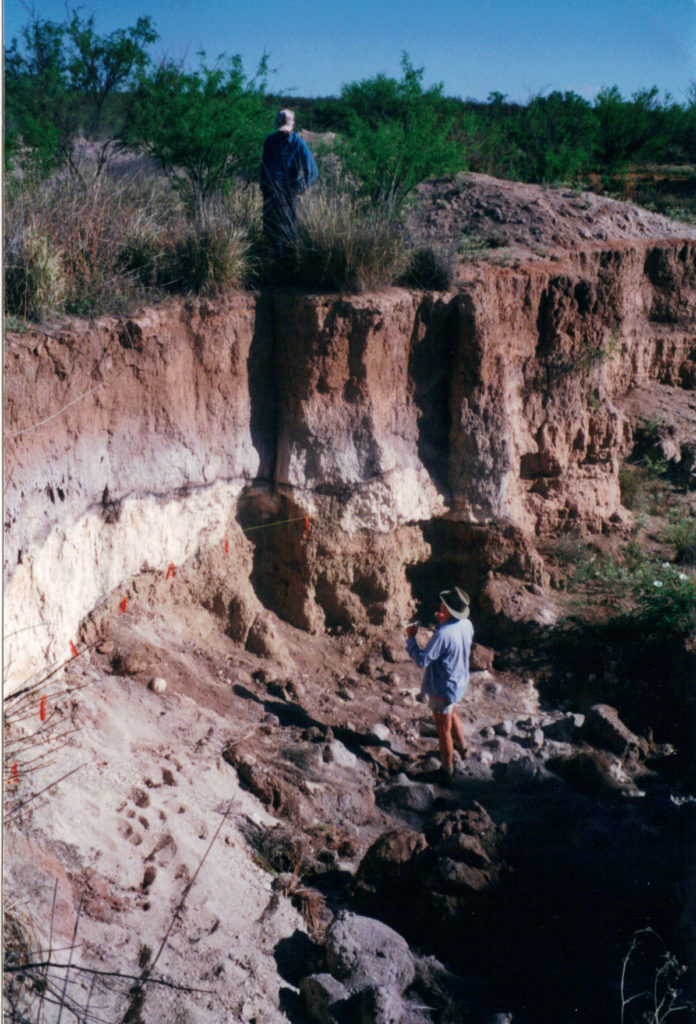
The Black Mat at the Murray Springs site, Arizona. by Sue Ruth
The second principle that Frere and Perthes used was the Principle of Association. The Principle of Association states that when remains of the past are near each other, they date to the same time period. Finding stone tools associated with mammoths at numerous sites indicates that humans were living alongside these now-extinct creatures. In the case of the Folsom site in New Mexico, a spear point was found in and around the bones of an extinct form of giant bison (Bison antiquus) that we know lived more than 10,000 years ago. This direct association with ice-age mammals and human tools led to the discovery that people were here in New Mexico during the last ice age.
Archaeology and other disciplines interested in the past rely strongly on the Principle of Uniformitarianism. Paleontologists and geologists also make use of this principle. Very simply put, the uniformitarian principle is the idea that the Earth and its life forms developed by the same natural processes in the past as in the present. That is the processes of mountain building, erosion, and basic chemistry and physics are the same as they were in the past. To use some very simple examples, archaeologists assume that stone tools will produce similar marks on bone today as they did in the past or that clay must be fired to the same temperature as it did in the past to become chemically altered into ceramic.
Based on what we see in the archaeological record and in genetic makeup, it is clear that people of the past were in every respect human, with the same intellectual capabilities, artistic impulses, and capacities for violence. While it may entertaining to consider the role of outside influences like aliens, lost races, or mythical beings like elves and fairies as contributing to our past, these claims have not stood up to the critical evaluation that extraordinary claims require. Often, people making these arguments have something to gain, especially fame and money. Erich von Daniken, for instance, who popularized his ideas of aliens interacting with ancient cultures in his wildly popular book Chariots of the Gods, was later convicted of fraud, forgery, and embezzlement and served time in jail. Ancient people are routinely underestimated and their achievements are sometimes assumed to be the work of a more intelligent society, extra-terrestrials, or even more perniciously a superior race of humans. Sometimes this assumption of ancient inferiority is overtly racist as in the case of the Great Moundbuilder debate which we will discuss in a later chapter.
The Three Great Questions: When? Where? What?
Question 1: When
Three essential questions are important to investigate the past. These can be distilled down to When? Where? and What? There are several dating techniques used in archaeology to understand when something occurred. Two general categories of dating are relative and absolute dating. Relative dates refer to the age of something compared with something else but do not provide a specific calendar date. The Principle of Superposition is an example of a simple relative dating technique. A relative date tells you whether something happened before or after something else. Absolute dates are an estimate of an actual calendar date. It is important to keep in mind that absolute dates are estimates of an actual date and are not necessarily perfectly precise. Two common methods of absolute dating are radiocarbon dating and tree-ring dating. These two are often used in tandem with each other. Radiocarbon dating works only on samples that were once living and is based on how much radioactive carbon has been lost after the death of the organism. We will discuss this method in more detail in a later chapter.
Tree-ring dating or dendrochronology is another absolute dating technique. Dendrochronology relies on the fact that trees add a ring of growth annually. The pattern of tree rings over time varies due to increases or decreases in rainfall and other factors. By overlapping and matching the pattern in tree rings of living trees with that of archaeological samples, we can date when a tree was cut in the past by counting rings from the rings from the present to the past. If you visit the New Mexico Museum of Natural History in Albuquerque, you can see an example of a long series of tree rings going back to the First Crusades around 1,000 years ago, also the period in which the famous Mimbres pottery was made in the American Southwest.
Sometimes events can be dated using absolute dating techniques, but their archaeological signatures can be used for relative dating. The Sunset Crater eruption is a good example. From alterations in the pattern of tree ring growth, we know that the volcano Sunset Crater in Arizona erupted between 1060 and 1080. Because the rings provide an estimate of a particular date in time for the eruption, it is an example of absolute dating. The eruption also left a visible ash deposit on many pueblo village sites in the area. Archaeological remains above the ash date to sometime after the volcanic explosion, and artifacts below the ash date to before the eruption. Using the layer of ash to determine the date of archaeological remains is a good example of relative dating.
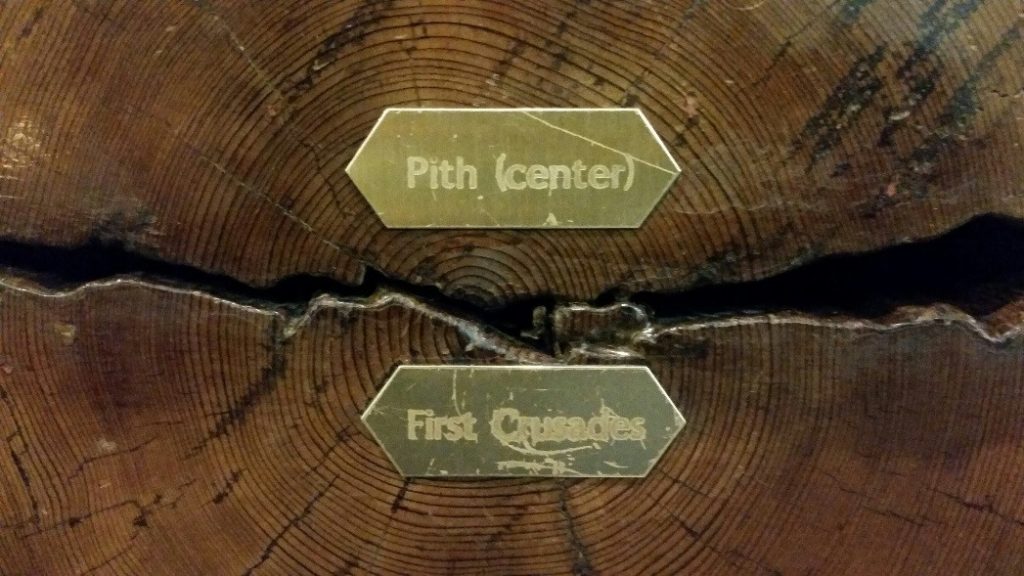
Example of tree rings from the New Mexico Museum of Natural History in Albuquerque. Photo: Sue Ruth.
Archaeologists use several different types of dating conventions to refer to time. Typically, for very old sites on the order of thousands of years old, archaeologists will use B.P. meaning “before present.” For more recent sites and artifacts, archaeologists tend to use BC/AD or BCE/CE. The terms BC and AD (Anno Domini) stand for “before the birth” of Christ and “in the year of our lord” or after Christ’s birth, respectively. The terms BCE and CE stand for “Before Current Era” and “Current Era” (also called Common Era). In short, BCE and CE are equivalent to BC and AD. The abbreviation for circa (ca.) meaning “approximately” is commonly used in archaeology because dates tend to be estimates and not exact dates, especially for very old sites not affiliated with written records. The shorthand “kya” stands for thousands of years ago and “mya” stands for millions of years ago.
Question 2: Where?
Context is critical to making inferences about the human past. Together, the provenience, matrix, and associated material culture make up an artifact’s context. The term matrix is used to refer to the surrounding soil or sediments. Provenience refers to an artifact’s actual physical coordinates, both horizontally and vertically—where is it on a map and how far down is it in the soil? An archaeologist is also interested in how an artifact relates to other artifacts, features, and structures. Without context, artifacts lose their ability to inform archaeologists about the past. Spatial context is why archaeologists dig square holes. Square holes or “units” are a way of knowing how much volume of the matrix has been removed with a little simple geometry. Archaeologists also dig in “levels,” removing one layer at a time in each square hole. Every artifact from that layer is bagged and labeled with the provenience, as in “Unit 1, Level 1.” In the lab, archaeologists can get a better sense of the overall site by analyzing the spatial location of artifacts using spreadsheets and mapping programs. This is a very far cry from the antiquarian days of old.
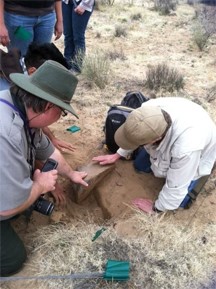
Recording with a GPS unit the spatial context of basalt grinding stone at Petroglyph National Monument. Photo Sue Ruth.
When people think of archaeology, they typically think of people who excavate ancient remains. A lot of archaeological work does not involve excavation at all. Survey occurs when surface remains are recorded. A survey is typically conducted to ascertain where archaeological sites are and to provide a plan for avoiding them when planning development projects. People are sometimes surprised to hear that after archaeologists record artifacts on a field survey, most of the time they leave them in place, or in situ. When CNM students surveyed part of the Petroglyph National Monument, no artifacts were collected; rather, everything was mapped using a GPS unit. There are at least three reasons for this. First, it is not feasible to collect everything and curate (store and protect) them in museums indefinitely. Secondly, archaeologists are more interested in what artifacts can tell us about the past than in amassing a collection of interesting objects like the antiquarians of old. And thirdly, and very importantly, the cultures affiliated with the artifacts often prefer to have them remain where they are.
Question 3: What?
The final basic question in archaeology deals with the remains themselves. This category is vast because it can cover shape, size, color, texture, hardness, and physical and chemical characteristics. Form, also called morphology, is especially important. The morphology of a spear point, ceramic vessel, or building can suggest function—how it was used in the past. The style of pottery or architecture can inform archaeologists about what culture it was affiliated with. The composition of an artifact can indicate where the object ultimately originated. For instance, the chemical composition of the bluestones at Stonehenge was used to identify their sources in the Preseli Hills, 140 miles from Stonehenge itself.
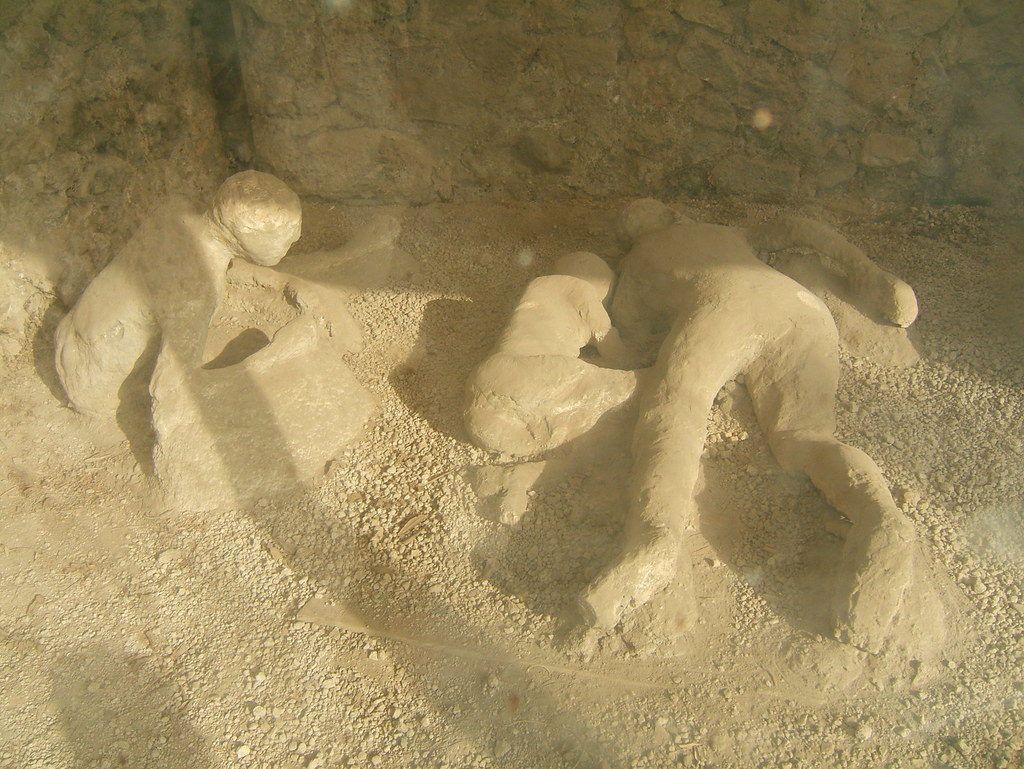
The bodies at Pompeii were in situ. The bodies were vaporized instantaneously following the volcanic blast and pyroclastic flow of Mount Vesuvius. The cavities left by their bodies were then filled in with plaster by early investigators. “Body shapes in the Garden of the Fugitives, Pompeii” by Andy Hay is licensed under CC BY 2.0
Type of Artifacts: A Few Common Terms
Archaeologists classify material culture into a few useful categories to discuss them quickly and easily. Artifacts are defined as portable objects made or modified by humans. The famous “Venus figurines” or woman figures of Europe’s Upper Paleolithic are good examples of artifacts. Archaeologists often use the word assemblage to refer to a group of related or spatially associated artifacts, as in the “ceramic assemblage” at a site. Ecofacts are organic and environmental remains resulting from human activity such as charcoal, pollen, and animal bones. Often, ecofacts are called by more specific names, for instance, animal bone, pollen samples, charcoal remains, soil samples, and so on. Features are non-portable objects modified or made by humans, such as hearths (fireplaces), pits, and ovens. Structures are simply the remains of houses, ceremonial chambers, shelters, temples, and other examples of architecture. Often only a portion of the structure remains as in the Roman house pictured below.
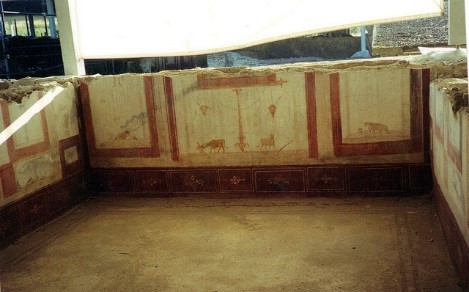
Remains of a structure at the Villa of Livia, Prima Porta, Italy. Photo: Sue Ruth
Human remains include human bones, teeth, and other tissues, and are typically studied by specialists in humans called osteologists. Finally, the term site (not sight) refers to spatial clusters of artifacts, ecofacts, features, human remains, and structures.
What’s Left to Observe?
Only a small fraction of the material culture that was in use survives today. Organic remains, those made from once-living things, like plant fibers, wood, and animal hide are the most fragile and prone to decay. The most resistant materials include stone, ceramics (fired clay), and glass. In an intermediate category are carbonized remains and metals. The matrix within which an artifact is located impacts its preservation. Bone, for instance, preserves well in alkaline soil environments but disintegrates in acidic ones. In cases like the ancient Maya of Mesoamerica, preservation of bone is very rare because of the highly acidic soils. Factors that promote decay include:
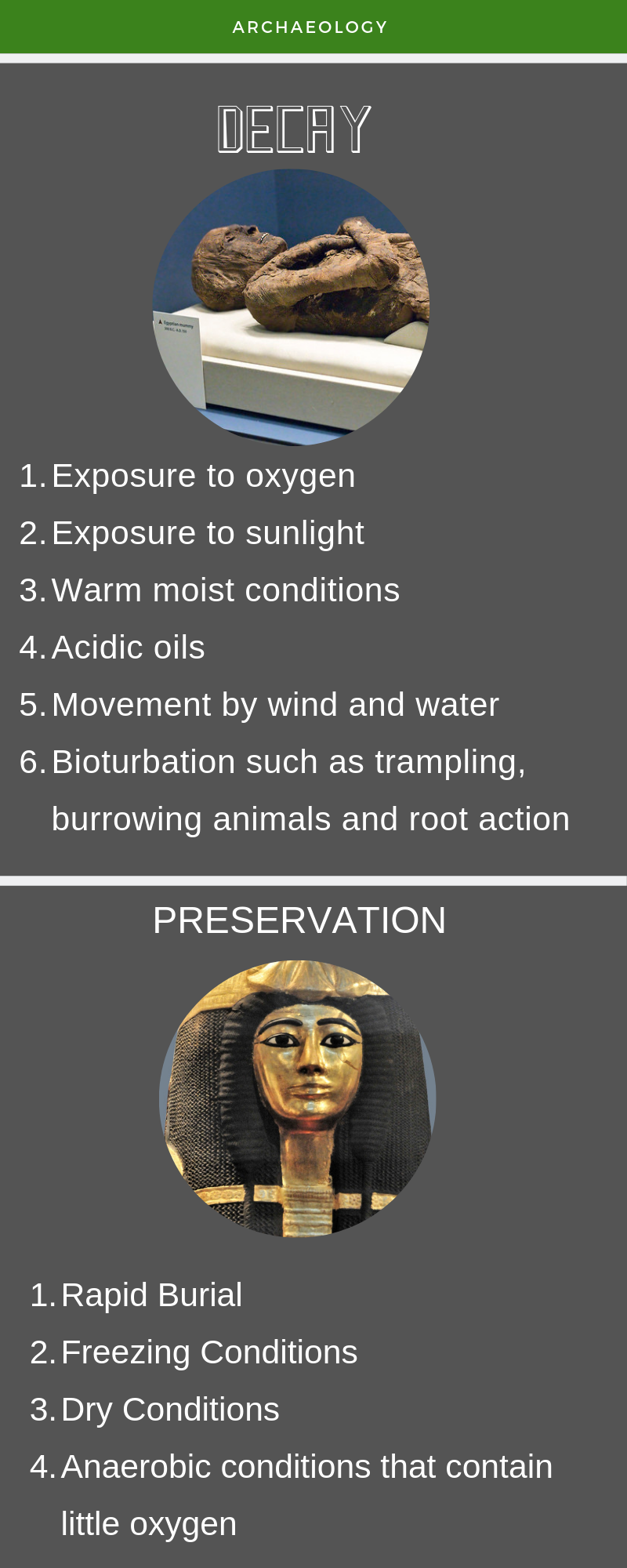
Because oxygen increases the speed of any chemical reaction, including decay, its absence helps preserve archaeological remains. An illustrative example of how freezing conditions can promote preservation is Özti, the Iceman of the Italian Alps. The Iceman was found eroding out of a glacier in 1991 by hikers and was originally thought to be a forensic case of a hiker who had gotten lost and perished on the glacier. After a few missteps, the investigators eventually realized, based on examination of the artifacts, that this was not a modern corpse at all. The Iceman dates back 5,300 years (ca. 3,300 BCE) and is the oldest example of a natural mummy in Europe. The Iceman also had with him wonderful examples of the technology of his day including a stone knife, a quiver of arrows, a longbow, and a copper ax. The ancient corpse was remarkably well preserved with the skin intact because it had been frozen in the ice.
Another remarkable story of preservation is the bog bodies of northern Europe, mainly Denmark, the Netherlands, England, and Ireland. The bog bodies are preserved in peat bogs. The bogs were low in oxygen because the rotting plant matter takes up the oxygen and the acidic peat naturally tans the skin. Sphagnum moss in the bogs also acts as an anti-bacterial agent further preserving the remains. While the skin and internal organs tend to preserve, bones dissolve in the acid matrix. Tollund Man of Denmark (ca. 2100–2200 BP) is the most famous bog bodies because of his astonishing preservation and serene countenance. The truth seems more grisly, however. Tollund Man had a rope around his neck and was likely intentionally killed. Most of the bog bodies date between 2500 BP (500 BCE) and 1500 BP (500 AD) and many were likely human sacrifices. Similarly, but not as disturbing, charred loaves of bread and other organic objects have been preserved under the ash at Herculaneum after the eruption of Mount Vesuvius in 79 AD because of the lack of oxygen.
Excellent preservation also occurs in landfills. William Rathje, the “garbologist” mentioned earlier, found that landfills, being deprived of oxygen are remarkably stable. Nothing decays in a landfill beyond a certain point. That’s good news for archaeologists interested in old trash, but bad for the current problem of where to put all our modern trash. Excellent preservation also occurs when sites are sealed by volcanic ash like Pompeii in Italy (A.D. 79) or Akrotiri on the Greek island of Santorini (ca. 1627 B.C.). Both these sites have remarkably well-preserved wall frescoes. The ash is sealed in the sites, preventing decay via oxygen, water, and wind. Organic material is also often preserved in arid locations. The American Southwest has excellent preservation, especially in dry caves. Arrows, baskets, sandals, seeds, and cordage (rope) are all preserved in dry caves. At McEuen Cave in Arizona, ancient pumpkin seeds look exactly like pumpkin seeds do today.
How Do You Find Sites?
Probably the number one question that archaeologists get asked is “How do you find sites?” One truthful response is that we don’t. People who are curious and observant, like Boucher de Perthes, typically find the most interesting sites. Kids, with their natural curiosity and general lack of responsibilities, are especially good at finding sites. Plus, they’re closer to the ground. The history of archaeology is filled with intelligent avocational archaeologists who read everything they can about archaeology and know where to look and what to look for. Also, non-professional archaeologists tend to think outside the prevailing paradigms of the day.
Another possible truthful response is that we look for them systematically and only when we have to. Federal agencies or projects that are supported with federal money are required to determine if the project will impact significant archaeological sites. In these situations, archaeologists systematically walk the landscape looking at the ground. Archaeologists train their eyes to spot stone tools, ceramics, and tell-tale stone alignments. Finding things becomes second nature like riding a bike. It is typical for an archaeologist, myself included, to see the tiny bead in the sand, but miss the rattlesnake.
When artifacts, features, ecofacts, or sites are encountered, they are recorded and the data are entered into a database. This is required because of legislation called the National Historic Preservation Act of 1966 (NHPA), which seeks to protect and preserve important archaeological and historical sites. If nothing is deemed significant enough to be added to the National Register of Historic Places, then the archaeologists’ work is done and the bulldozers and backhoes come in and development continues. If the site is deemed to have information potential, then portions of the site are excavated, the data are recorded, a report is written, the artifacts are curated, and then the development proceeds. In very rare instances, a site is found that is so significant that the project is redesigned or canceled. Most archaeologists are involved in conserving and managing sites, a profession called cultural resource management or CRM. When CNM students participated in a survey at the Petroglyph National Monument on federal lands, they were acting under the NHPA because the Monument had plans to refurbish the trail which could impact archaeological sites.
Sometimes sites are found accidentally during development. For example, when the Jeanette Stromberg building on CNM’s Main campus was renovated in 2011, a portion of a historic cemetery dating to the late 19th and early 20th centuries was encountered (The TVI Cemetery Site). The cemetery was previously excavated in 1984 when the building was first constructed. Archaeologists from the Office of Contract Archaeology excavated the three burials, and osteologists at the Human Osteology Laboratory at UNM analyzed them. Once the burials were analyzed and a report was completed, renovation continued. (Pro-Tip: Google search “Jeanette Stromberg” and “ghost”).
In addition to protection on federal land, archaeological sites are subject to state laws on state-owned and private land. For example, burials, marked or unmarked, are protected in New Mexico on both private and public land under the New Mexico Cultural Properties Act of 1978. Under this same legislation, it is unlawful to excavate an archaeological site with heavy machinery on private land. Excavation on state land requires a special permit.